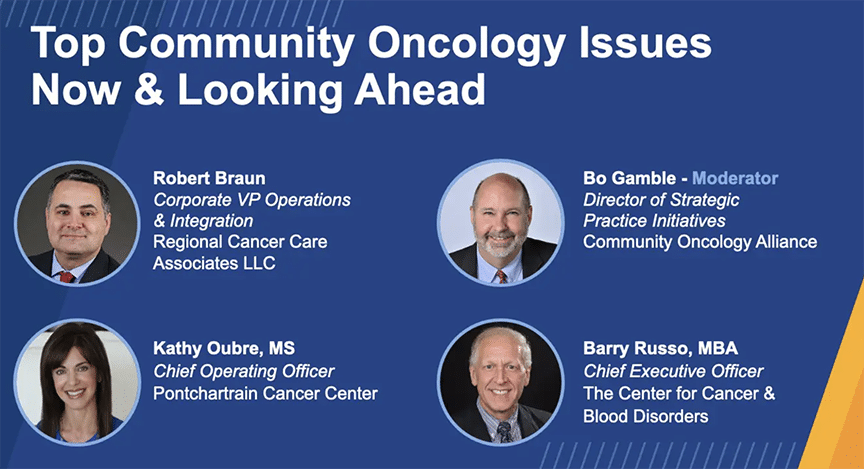The Community Oncology Alliance’s recent virtual conference featured a panel of community cancer care providers assembled to discuss the most pressing issues they face as they implement extensive changes to respond to the COVID-19 pandemic.

The panel was moderated by Bo Gamble, Director of Strategic Practice Initiatives for Community Oncology Alliance and included:
- Robert Braun, Corporate VP Operations & Integration, Regional Cancer Care Associates
- Kathy Oubre, MS, Chief Operating Officer, Pontchartrain Cancer Center
- Barry Russo, MBA, Chief Executive Officer, The Center for Cancer & Blood Disorders
So how has patient care changed since the start of the pandemic?
When the panel was asked what patient care will look like moving forward, the discussion turned to technology. All of the panelists described quickly implementing telehealth in response to COVID-19 and they have found patients are adapting easily to these types of visits. Kathy Oubre from Pontchartrain Cancer Center said her center has seen an increase in patient satisfaction – patients appreciate the transparency and they are reassured, knowing their safety is so important.
Barry Russo from the Center for Cancer and Blood Disorders anticipates that patients will expect access to telehealth as a standard part of care from now on. He went on to point out that electronic communication is going to play an increasingly important role for cancer care. In addition to the complexity of cancer care, you also take into account value-based care programs where the intent is to spend more time with patients, not less. So how do you achieve that in the post-COVID world? Providers are going to have to restructure how they accomplish this and technology will be an important part of communicating in the future.
Leveraging technology amidst COVID-19
It is likely that social distancing, especially for cancer patients, is here to stay so providers are going to need technology to stay connected to patients. Electronic patient-reported outcomes (ePROs) provide an excellent way to do that when patients are away from the clinic.
You do not want vulnerable patients sitting in emergency department waiting rooms or going to the hospital unless it’s absolutely unavoidable – now more than ever. Proactive symptom management is essential and ePROs give care teams that added interaction know what’s happening and when patients need assistance. An ePRO tool that prompts patients to let their care team know what’s happening is especially powerful since patients may not always know what to report or when to ask for help.
Technology can also give care teams digital tools to provide psychosocial screening and support; deliver targeted information in an automated and timely way; and stay closely connected to patients. This is an opportunity to improve care and provide added support to patients since it also gives care teams a deeper understanding of the patient journey.
What will cancer care look like in 5 years?
Robert Braun of Regional Cancer Care Associates described the new norm he sees: more technology and expanded communication methods. Barry Russo added that he sees interactions with patients becoming more frequent and more electronic. Staying connected is essential and patients are adapting fast to technology, so creating more electronic environments to include all members of the care continuum will need to be standard.
The COVID-19 pandemic accelerated the adoption of telehealth and it’s reportedly been very well received by patients and care teams alike. Care teams can build on that momentum to expand their use of technological tools that are going to be essential to high quality, comprehensive cancer care.
Not sure how to get started? Contact Navigating Cancer – we can help.
